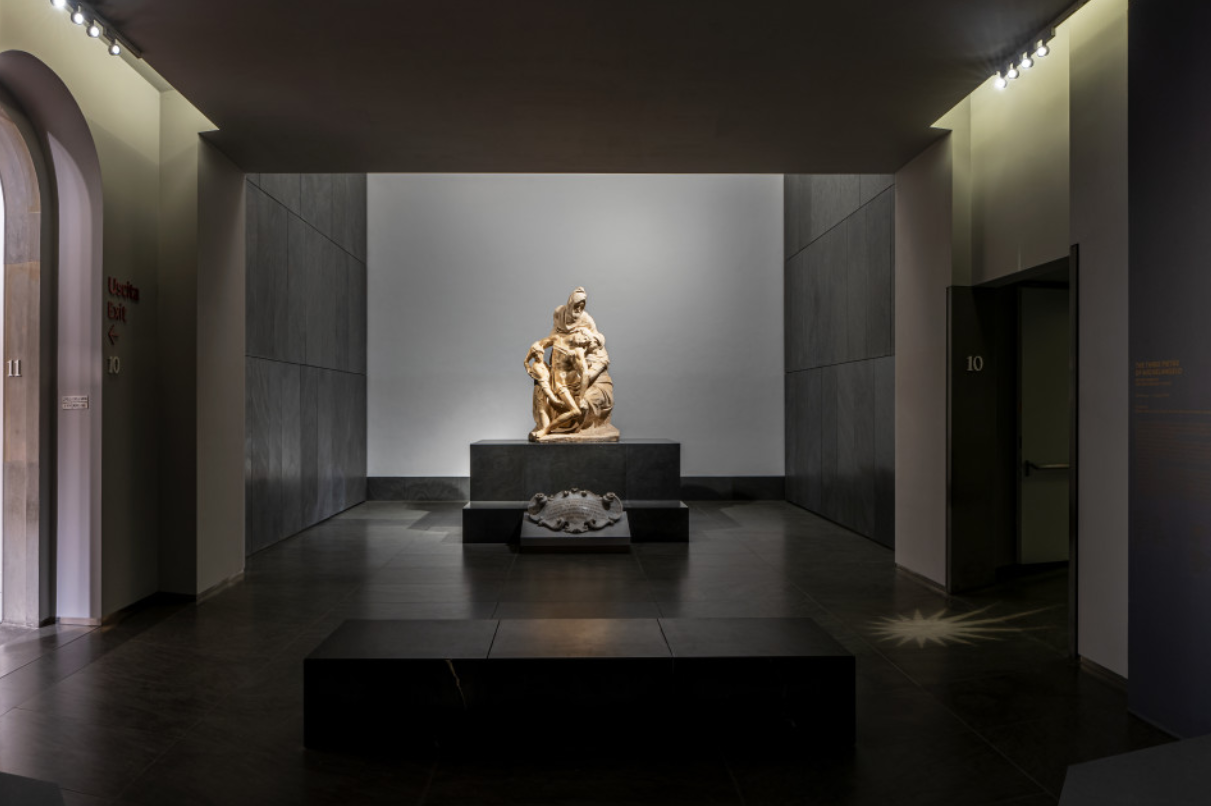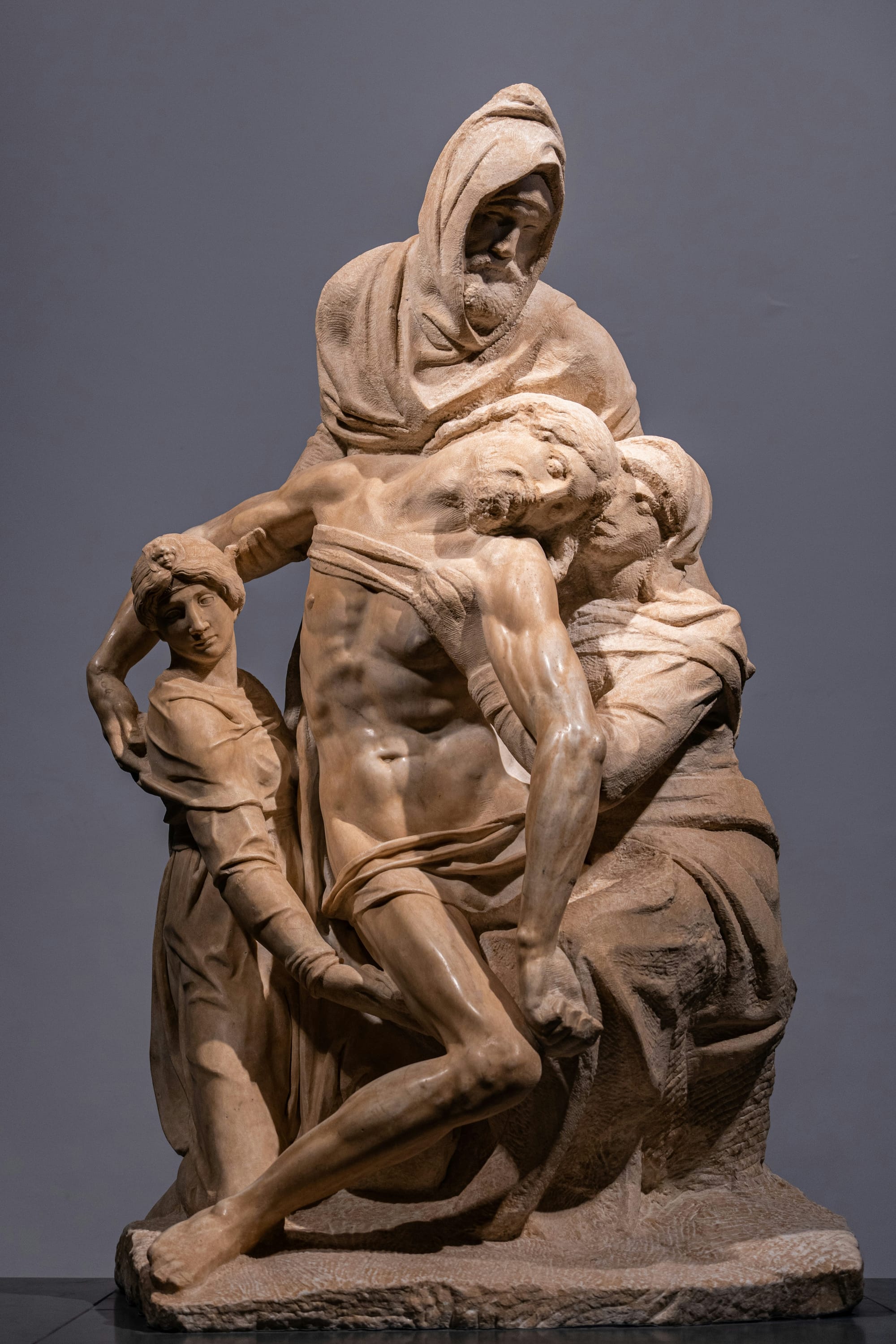Michelangelo’s Pietà Bandini: The Unfinished Masterpiece and Its Dark Legend
Step inside the Museo dell'Opera del Duomo and discover why visitors feel a presence that seems alive, lingering in unfinished stone.

Have you ever felt as if a piece of art was watching you back, not out of beauty but as if it held something unspeakable, something waiting to be discovered? Imagine stepping into a dimly lit gallery, the air heavy and silent, as though time itself held its breath. You are alone but for Pietà Bandini, one of Michelangelo’s final, unfinished masterpieces. As you approach, a chill creeps up your spine, settling around you with an unmistakable weight—a feeling so familiar it stirs memories of childhood nightmares, those dark hours when shadows seemed to move, carrying whispers you weren’t ready to hear.
This isn’t just any sculpture. Pietà Bandini seems alive with a story locked within its stone. You sense it in the way the figures—Christ held by Mary, watched by two shadowy figures—almost seem to reach out to you, each bound by Michelangelo's incomplete hand. But legends say that Pietà Bandini doesn’t just call out to anyone.
Michelangelo himself heard whispers one night while working alone in his workshop. The only sounds in the room were his hammer and chisel, sharp and rhythmic, until a faint voice broke the silence—not from a human, but from the stone itself. “Stop,” it whispered, urging him with a cold finality. Imagine standing there, hearing that voice weave through the stillness, filling your mind with an unyielding insistence. Was it merely fatigue? Or something else, something that had taken root deep within the marble?
Unable to silence the voices, Michelangelo made a drastic choice. He shattered part of his own creation, breaking Christ's hand, leaving the sculpture forever incomplete. Since that night, Pietà Bandini has seemed to carry his torment, drawing in those who dare to stand before it. Some visitors describe a chill, an unseen presence coiling around them. Others swear they've heard faint whispers, lingering in the silence, as though the unfinished story is still being written.
And you can’t help but wonder—could it happen to you? What if, in that gallery, standing before those haunting, unfinished faces, you hear that whisper, faint but relentless, calling for you?

Michelangelo’s Descent into Darkness
By the time Michelangelo began work on Pietà Bandini, he was no longer the vigorous artist of his youth but a man worn by years of struggle, loss, and an intense preoccupation with mortality. At nearly 70 years old, he carried the weight of his life’s work like an unseen shadow, knowing that his own end drew closer. In the dim quiet of his workshop, he set out to sculpt one final masterpiece—a Pietà that, unlike his earlier works, bore a spectral quality, as if imbued with sorrow. It would be his farewell, a reckoning with both life and death. Yet as his chisel struck the stone, something darker seemed to awaken.
Michelangelo often worked alone through the night, the quiet enveloping him like a cloak as he chipped away at the stone. The faces of Christ and Mary emerged, etched with an anguish that felt strangely familiar, almost as though he was carving his own dread into the marble. But as he shaped each figure, the stone felt… watchful. He could feel it—figures whose gazes seemed to linger on him, whose expressions seemed to shift ever so slightly in the flickering candlelight. The quiet was all-consuming, pressing in around him.
And then, one night, the silence broke. He first noticed it as a faint, soft sound, like fabric brushing against stone. Dismissing it as the result of his own fatigue, he returned to his work. But the sound grew, twisting through the room until he could no longer ignore it. "Stop," the voice whispered, low and cold, settling deep into his mind. He felt it prickle along his spine, an unmistakable presence—something that was not his own. The whisper wasn’t urgent; it was resolute, as though it had been waiting in the stone all along.
The nights that followed were haunted, the voice ever louder, winding through his mind like smoke, wrapping around his thoughts until it was unbearable. His sanctuary had become a prison of whispers, his steady hands shaking, his heart gripped by the relentless voice. In a final, desperate act, he raised his chisel and struck Christ’s arm, breaking it from the figure with a crack that echoed through the room, leaving his work forever incomplete. The silence that followed felt heavy, oppressive, yet the voices had stopped. The break was a release, a severing of the darkness that had claimed his mind.
But the echoes of his decision did not end with him. The fractured arm, the unfinished face—each detail seemed to carry a residue of Michelangelo’s torment, his suffering bound forever in the marble itself. Since his death, countless visitors who have stood before Pietà Bandini have described a coldness, a silent presence, or whispers that linger in the air, faint yet insistent, as though Michelangelo’s anguish lives on, waiting to be felt by anyone who dares to draw close.

The Haunting Legacy: Whispers from Stone
Today, Pietà Bandini stands as a haunting testament to Michelangelo’s final years—a masterwork born from both genius and despair. Though centuries have passed since he laid down his chisel, visitors who come close to the statue speak of an uneasy feeling, as if the artist’s torment still lingers within the marble. For those who approach, the experience is not one of peaceful reflection but of unsettling intimacy, a sensation that deepens with every step closer to the statue’s fractured form.
For some, there is an almost suffocating weight in the air, a pressure that presses against their skin, urging them to turn back. A chill seeps through the silence, gathering in the room like a shadow in the corners. And sometimes, visitors claim to hear faint whispers—just on the edge of sound, like a voice caught between silence and speech. It rises, indiscernible, then fades, as though the stone itself were straining to speak. The murmurs, some say, are almost pleading. Others insist they are a warning.
Those who linger in the statue’s presence feel an uncanny sensation that the figures—Christ, Mary, and the shadowy witnesses—are watching, their stone eyes bearing sorrow, and perhaps something colder. They feel the weight of a private grief, as if Michelangelo’s own anguish is etched into every line of the marble. The feeling is inescapable, following them long after they leave, like a memory that refuses to fade.
And yet, the experience compels, as if an unfinished story is waiting for those who will stand long enough to listen. Imagine standing there, in that hollow silence, the broken arm of Christ a solemn reminder of Michelangelo’s desperate act. Would you feel the gaze of those sorrowful eyes urging you closer? Would you hear the faint whisper that has unsettled so many before you, the silence shifting, drawing closer, revealing secrets you might wish you hadn’t heard?
If you ever find yourself before Pietà Bandini, take a moment. Listen closely, and don’t be surprised if you feel a chill. After all, what is left unfinished doesn’t simply disappear—it waits, lingering in silence, just out of reach, calling to those who dare to listen. And perhaps, as you stand in that solemn silence, you’ll feel it too—a faint, relentless whisper that will follow you, a voice waiting to be heard, as if the stone itself remembers.
ART Walkway News





